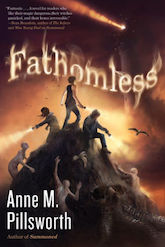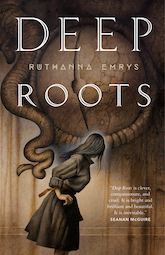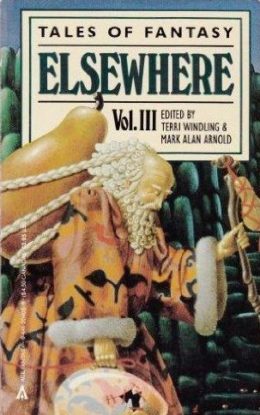Welcome back to the Lovecraft reread, in which two modern Mythos writers get girl cooties all over old Howard’s sandbox, from those who inspired him to those who were inspired in turn.
This week, we’re reading Joanna Russ’s “The Little Dirty Girl,” first published in 1982 in Terri Windling and Mark Alan Arnold’s Elsewhere, volume 2 anthology. Spoilers ahead.
“Oh yes I do,” said the Little Clean Girl. “I live up the hill and under the hill and over the hill and behind the hill.”
Summary
Narrator writes to an unnamed correspondent. Does correspondent like cats? She’s allergic to them, yet they flock to her, twine around her ankles, demanding. She dislikes children (no, she feels awkward around them), yet little boys often make her their confidante. She’s exposed to these aggressive felines and youngsters on her daily therapeutic walk. The doctor says her back will eventually heal, but when? She injured it by “flogging myself through five women’s work and endless depressions, beating the old plough horse…for decades…until her back broke and she foundered and went down and all I could do was curse at her helplessly and beat her the more.”
It’s summer in Seattle now. Come autumn, she’ll return to university, teaching writing and dodging such “unspeakable” demands as students with thousand-page trilogies.
The Little Dirty Girl first approaches narrator in the supermarket. She’s about eight, and spectacularly dirty: long black hair a tangle, shoes down at heel and laces broken, white socks grayed, ancient pink dress wrinkled. Her knees are skinned. Snot and tear marks streak her sallow face. She looks “ignored, kicked out, bedraggled, like a cat caught in a thunderstorm,” and her voice is gravelly as a raven’s. “I like those,” she grates, meaning the Milky Way bars at which she points. Not begging. Just saying. She accompanies narrator down the aisles, unafraid (narrator thinks) not because she trusts the older woman but because she trusts nothing and has no hopes or expectations. Finally narrator asks the LDG her name. To which LDG replies, “A. R.”
Those are the initials on our narrator’s handbag. She tells LDG she doesn’t believe her. “I could tell you lots of things you wouldn’t believe,” LDG says.
At the cashier, LDG cadges a Milky Way bar from narrator, after all. She then insists on riding home with her to help with the packages. In close quarters, LDG smells bad, of “demanding-ness, neediness,” but LDG promises she’ll leave after helping, and she does, though not without (1) insisting her name is A. R., and (2) shouting she’ll be back.
On LDG’s return, narrator invites her inside, where LDG goes into raptures over her books, pictures, office, declaring them “sophisticated” and “swanky.” Narrator gives her a peach and milk, then replaces the missing buttons on her dress and plaits her “wandering Fury’s” hair into decent braids which LDG finds too “conventional.” Before she rushes off into the rain, narrator gives her a green poncho, then goes inside to find the food untouched.
She puts Milky Way bars on her shopping list.
LDG returns to eat them, and an astonishing variety of other junk foods. Narrator indulges her. They take walks, visit shops. A merry-go-round ride drives LDG into a screaming dervish whirl, but only the embarrassed narrator seems to notice. Nor, when narrator finally dares to bathe LDG, does anyone notice when the girl capers naked around the house. Narrator dresses the no-longer-Dirty Girl in her laundered pink dress, to find it’s now too big, as if the LDG has “youthified.” Not for the first time, she asks, “Where do you live?”
LDG answers, “If you knew, you wouldn’t want me.” She then describes, in fine detail, how narrator has imagined following her. But you’d better not try. It’d only scare you. An unnerving conversation follows, ending with narrator’s promise that though she can’t give LDG everything she wants, she’ll try to give her everything she needs.
Narrator has long realized she’s dealing with a ghost. The unchanging, antique clothes were an early giveaway, and how no one else notices LDG, and now LDG’s been shrinking, age-wise, from eight to five. Some aspects of LDG, her junk food gobbling and dirt, are solid enough, but narrator still grows anxious when school starts and LDG hasn’t returned. Then comes the first cold winter rain. Followed by a knock on the door in the night, and it’s the LDG, soaked and shivering and coughing and glowering miserably. “You hate me!” the spectre croaks. “You starve me! You want to clean me up because you don’t like me dirty! You won’t give me what I need and I’m dying!”
“A. R.—” narrator says, and LDG screams, then doubles up in convulsive coughing. All LDG can get is from narrator, she raves. And what she needs—is our narrator.
So that’s it, another cat, dependency. Narrator realizes LDG could kill her if she doesn’t get what she wants. But she’s suffering, and a demon child is still a child. Narrator kneels. With the warning, “Be careful of my back,” she lets the “terror of the ages” walk into her arms. As LDG weeps there, narrator knows she loves all of her, dirt, wounds, anger, whims—she will take care of her forever.
What follows is a delirious, hilarious bubble bath, and LDG wrapped in narrator’s too-big pajamas in bed beside her. She’s gone in the morning. Her clothes last a little longer, then fade “into mist or the elemental particles of time or whatever ghosts and ghost-clothes are made of.” It’s not story’s end. Narrator’s mother, with whom she’s always had a distant relationship, visits; they reach a beginning reconciliation likely impossible before LDG. Mom confesses the reason for her distance, her secretiveness: from the time narrator was a little girl (maybe about LDG’s age), she was being treated for cancer. She never said anything, until now.
And LDG? She’s still around. She clamors for donuts at the bakery, and to stay up late and read and sing, and to go to parties and talk to new people. Narrator knows now she’d be lost without LDG. Besides, “one ignores her at one’s peril.”
Recently LDG clamored to have her picture taken, and narrator encloses it to her correspondent. Does correspondent doubt the photo is of her? Look at the pitch-ball eyes and thin face. Never mind the gray hair and air of being much older.
Besides, hasn’t correspondent always desired most in the world a photograph—of A.R.?
What’s Cyclopean: Feral cats wreathe our narrator’s feet, crying Dependency! Dependency!
The Degenerate Dutch: Narrator makes a point of explaining why the little boys who punctuate her walks are “alabaster” – “this specific part of Seattle” is in fact a pretty reasonable explanation.
Mythos Making: The narrator does start as a bit of a Lovecraftian loner, nervous of the effects of human contact.
Libronomicon: On her first visit to Narrator’s house, the Little Dirty Girl reads her book of microphotographs.
Madness Takes Its Toll: Narrator considers writing a “psychotherapeutic letter” to her house’s previous owners, to try and track down the cause of her haunting.
Buy the Book


Fathomless
Anne’s Commentary
Question of the week: What is a ghost anyway?
We know that The Weird editors Jeff and Ann VanderMeer consider both Irwin’s “Book” and Russ’s “Little Dirty Girl” ghost stories because they say so in their introduction to the former tale. Russ’s narrator calls her “visitor” a ghost, so okay, “Little Dirty Girl” is in. But Irwin only mentions ghosts to note that protagonist Corbett doesn’t believe in them, while Corbett identifies his persecutor as the book (source of power) and its agent (the directed power or force that moves volumes and opens doors, for example)—it’s daughter Jean’s psychic eye that’s keen enough to see the “agent” as a phantom hand.
Oh, never mind the word ghost. Irwin uses enough tropes for us seasoned field supernaturalists to identify the disturbance in the Corbett household as the postcorporeal spirit of the book’s 17th-century author. Not the least being the appearance of fresh writing in his crabbed 17th-century hand.
Right. A ghost must be the spirit or soul or residual psychic energy of a dead person, then. A. R. decides her Little Dirty Girl must be a ghost because she can check off point after point on the Standard Specter Checklist: Antiquated clothing (circa 1945); items given to her remain with narrator; other people can’t seem to see her; unchildlike canniness in withholding personal information; impossible physical alterations (accelerated aging backwards.) What can have been LDG’s tragedy? How can A. R. help her resolve it and rest in peace? Because that’s what’s ghosts want, you know. To RIP after resolving death-related tragedy. Or taking revenge on their murderer(s). Or contacting loved one(s). Or pointing out hidden stuff, often treasure or their own lost remains.
Wait. There are also lots of ghosts who just want to be jerks, forever and ever, amen. They post-exist only for the thrill of scaring the crap out of the living, or so it seems to us living. Take whatever walks alone in the greatest of all haunted domiciles, Shirley Jackson’s Hill House. Doesn’t it know every trick in the tome for terrifying paranormal investigators? Hasn’t it learned to get under their skins and into their deepest fears, maybe because—
Because it, wait again—
Maybe because it IS them! Maybe certain places or situations cause living people to create ghosts. Living people like Eleanor Vance, poor Eleanor associated with poltergeist activity in her childhood, capable perhaps in a psychic superbattery like Hill House of remote-scrawling self-referential graffiti on the walls and ruining vain Theodora’s clothes with blood, of manifesting horrors to prowl the halls at night and pound on doors, to weep like tormented children.
One theory about poltergeists is that they are external expressions of internal emotional trauma, usually that of an adolescent girl. They’re not independent remnants of the dead but creations—extensions—of the living. The Little Dirty Girl is no poltergeist in the classic sense, though she can make noise and mess enough. She is, however, an extension of A. R., specifically an embodiment of A. R.’s near-lifelong suppressed LDG, the creature of impulse and rage and rapture, of wanting and needing and demanding, of a self-regard so long denied that it must now clamor for attention in the form of raw, monster-childish selfishness.
LDG tells A. R. the truth upfront—she, too, is A. R., a starved and neglected aspect of her, a living ghost, but barely. She reminds me of William Wilson’s moral-watchdog of a doppelganger, except a quirky-charming variation on the theme. She’s not A. R.’s identical twin but a younger and bedraggled (and still younger and still more bedraggled) version.
As with all ghosts, whatever their sort may be, the question arises: Is LDG a “real” ghost, autonomous, or does she exist only in A. R.’s mind? A. R. believes LDG leaves behind concrete (and dirty) proof of her independent reality. Can she be objective, though? Can she, if where LDG’s concerned at any rate, she’s lost in self-delusion?
Or, third choice, could A. R. be willfully lost in an extended metaphor, spun out for her unnamed correspondent? She does teach writing, we learn. Probably fiction, from the sound of those trilogy students who chase her in the halls. Fiction writers, you know. You just can’t trust ‘em. You can, however, purr in delight at their verbal pyrotechnics, like Russ’s opening riff on the types of cats, and feel a heart-squeeze at their piercing pathos, like her description of how LDG’s clothes vanish, the last physical bit of her (a shoe) becoming “the shadow of one of the ornamental tea-cups on the mantel.”
Buy the Book


Deep Roots
Ruthanna’s Commentary
This is a brilliant story—as one would expect from Russ—even though one can definitely see the land of glurge from its banks with a good telescope. What it isn’t, slightly to my startlement, is anything approaching Lovecraftiana or cosmic horror. Clearly either the VanderMeer’s definition of weird fiction makes an imperfect Venn with mine, or they just couldn’t resist anthologizing this story. Can’t say I blame them.
Ghost stories, a most traditional form of horror, can skirt the edge of the weird to begin with. We’ve explored them before heading in backwards, via Lovecraft’s SFnal deconstructions of the whole trope. His houses were haunted by alien fungus vampires and dimension-traveling math genius witches. Bulwer-Lytton simulates hauntings via mesmeric vengeance. Stoker and Rickert’s ghosts are relatively standard dead people of dubious morality, but have the Lovecraftian quality of being Things Man Was Not Meant to Spend the Night With. Perhaps the closest to “Dirty Little Girl” that we’ve come before is the glorious “How Fear Departed From the Long Gallery,” where life-sucking child-ghosts really just need to be treated like kids, in order to properly make themselves at home with the Peverils—clearly cousins to the better-known Addams family, and A.R. clearly has some relation, to deal so practically with an apparent haunting.
There’s a moment in “Dirty Little Girl” where A.R. (Sr.) clearly thinks she is in the more horrific sort of story. The sort where the spirit that needs YOU is going to consume your soul, or convince you to hand it over through some sort of charismatic mind-control. But the hold that A.R. (Jr.) has over our narrator is a more, dare one say, natural one. It’s a very 80s sort of haunting, in fact. I’m pretty sure that only Russ could have gotten away with a Healing Your Inner Child haunting without making me roll my eyes. And the edge of wondering if this is horror is part of it. Lovecraft’s narrators always seem to be reasonably confident of their genre—even in denial, they deny that they’re in a cosmic horror universe and not, say, a splatterpunk one. A.R. tests hypotheses: Haunted house? Nope. Psychic vampire? Phew. Unloved younger self, in need of neglected parental care? Check!
Much of what makes this story work, and keeps it at telescope distance from sentimentality, is that pragmatism, and the details that result from both A.R.s’ clear-eyed observations. The Little Dirty Girl won’t eat peaches, but tears through candy bars. A.R. Sr. sings silly versions of Handel’s Messiah. LDG explains the creepy scene that will result if A.R. tries to follow her “home,” so A.R. doesn’t try it. Sentimentality may press up against them, but they’re bound to push it away, like a cat crying dependency, and continue with their snot-filled, scabby, meaningful connection.
The title is interesting—why is A.R. Jr. a “little dirty girl” and not “dirty little girl”? English has a very specific order for adjectives and this isn’t it. There’s something about the girl, then, that makes being “dirty” more fundamental to her nature than being “little.” She says it herself (in a screamy six-year-old sort of a way)—she needs, not to be cleaned, but to be loved with all her dirt and nastiness. As does A.R. Sr., no longer little.
Last question, and not one to which I have a clear answer—though I wonder if there is one that I missed. Who’s getting this letter? Who does A.R. trust enough to tell this story, who’s never seen a picture of her, let alone met her in person? Perhaps this relationship of letters is the story’s most truly Lovecraftian element.
Next week, in Ray Bradbury’s “Skeleton,” we consider whether the most terrifying enemy may lie within.
Ruthanna Emrys is the author of the Innsmouth Legacy series, including Winter Tide and Deep Roots. Her neo-Lovecraftian stories “The Litany of Earth” and “Those Who Watch” are available on Tor.com, along with the distinctly non-Lovecraftian “Seven Commentaries on an Imperfect Land” and “The Deepest Rift.” Ruthanna can frequently be found online on Twitter and Dreamwidth, and offline in a mysterious manor house with her large, chaotic household—mostly mammalian—outside Washington DC.
Anne M. Pillsworth’s short story “The Madonna of the Abattoir” appears on Tor.com. Her young adult Mythos novel, Summoned, is available from Tor Teen along with sequel Fathomless. She lives in Edgewood, a Victorian trolley car suburb of Providence, Rhode Island, uncomfortably near Joseph Curwen’s underground laboratory.










